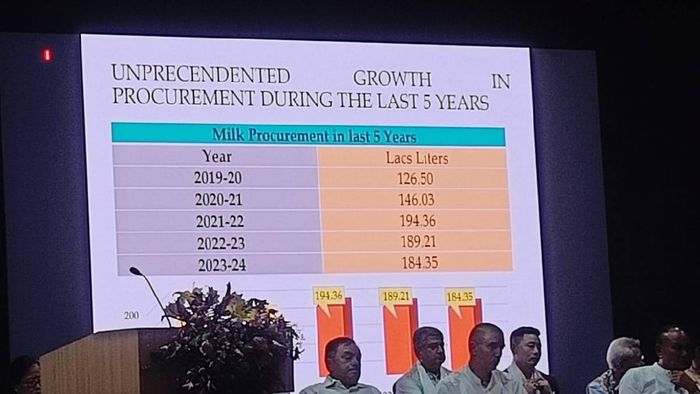Sikkim gets Gwala app on 4th foundation day, revives Dentam cheese plant
The Sikkim Milk Union celebrated its 4th Gwala Diwas on July 1, marking substantial progress since its formation in 1980. The event saw the launch of the Gwala app and the revival of the Dentam Cheese Plant, aiming to boost local cheese production and modernise dairy operations.

- Jul 01, 2024,
- Updated Jul 01, 2024, 1:57 PM IST
The Gwala app was launched and Dentam Cheese Plant was revived during the 4th Gwala Diwas which was organised by the Sikkim Milk Union on July 1. The event highlighted the impressive progress made by the union since its inception in 1980.
The union began with 2,000 gwalas and 51 societies and has now expanded to 512 dairy cooperative societies.
A significant announcement made during the event was the revival of the Dentam cheese plant, which was previously managed by Amul. The plant will now undergo restoration to boost local cheese production, a move expected to enhance the dairy industry in Sikkim.
The Gwala app was also launched to modernise and streamline dairy operations. The technology aims to facilitate dairy farmers by providing access to essential resources and information, ensuring efficient milk collection and processing.
The Managing Director of the Sikkim Milk Union, T B Ghatani acknowledged the challenges faced due to the outbreak of the Lumpy disease last year, which adversely affected milk production. However, he expressed optimism about overcoming these hurdles and achieving higher production levels in the coming years.
Sikkim Milk Union: A Journey from 1980 to 2024
The Sikkim Milk Union, an autonomous body of dairy farmers, was registered on April 29, 1980, with its head office at 5th Mile Tadong, Gangtok, and a regional office at Karfectar, Jorethang, South Sikkim. The union's formation was influenced by the white revolution of the 1970s under the National Dairy Development Board (NDDB), following the AMUL pattern.
Initially, the union started with 51 primary dairy cooperative societies (DCS) and 2,000 registered members, collecting 2,191 liters of milk. The first milk processing plant at 5th Mile Gangtok began operations on July 1, 1980, the day now celebrated as Gwala Diwas. Today, the union boasts 512 functional registered DCSs, pouring an average of 52,544 liters of milk daily.
The primary aim of the Sikkim Milk Union is to facilitate milk collection in remote areas and deliver quality milk and milk products to consumers. The objectives include ensuring the prosperity of dairy farmers through customer satisfaction and continuous support.
The union operates under the jurisdiction of Gangtok, Pakyong, Namchi, Galyshing, and Soreng districts. Its governing body consists of 17 elected board members, representing 17 territorial constituencies among registered members, with a tenure of five years. The board also includes three nominated members: the Secretary of AH&VS Department, the Registrar of the Cooperation Department, and the Managing Director of Sikkim Milk Union. The current workforce stands at 208 employees.
Three Key Sections: Procurement, Processing and Marketing
Procurement and Input (P&I): The union procures milk from five districts, processes it in plants, and markets the products. It also processes slurry for organic manure and cooking gas, benefiting 120 families through the Kamerey Biogas plant.
Processing Plant: The processing plants ensure the quality and safety of milk and milk products, maintaining high standards.
Marketing: The marketing section is responsible for distributing milk and milk products, ensuring they meet consumer needs.
The average daily milk procurement has seen unprecedented growth, rising from a modest 2,121 liters per day in 1980 to 52,544 liters per day at present. The union has consistently increased its procurement, with significant milestones achieved over the decades.
The introduction of a Rs 8 per liter milk incentive has significantly boosted milk payments, which have increased from Rs. 4,764.10 lakhs in 2019-20 to Rs. 8,447.74 lakhs in 2023-24. This incentive has been a major factor in supporting dairy farmers and enhancing milk production.
The union provides various facilities to societies, including automatic milk collection units, milk chilling facilities, biogas plants, and support for society house and BMC shed construction. These facilities ensure efficient milk collection and processing, benefiting both farmers and consumers.
The union conducts awareness programs for farmers, covering topics such as society registration, regular auditing, handling and safety of cooling and collection facilities, and the benefits of high-quality cattle feed. These programs aim to improve milk production and ensure the well-being of dairy farmers.
A study to assess the feed, fodder, and mineral mixture scenario in Sikkim is underway. The union aims to raise awareness about the nutrient composition of locally available fodder and the risks associated with certain feed ingredients. Efforts are also being made to cultivate high-protein fodder crops and mobilise cooperative members for extensive cultivation.
The union focuses on improving the productivity of milch cows by providing high-quality feed, mineral mixtures, and nutritious grasses. Initiatives like farmer insurance, interest-free cow loans, and cattle insurance aim to enhance the financial health of dairy farmers and the union.